The following guide will provide a snapshot overview of the Dark Jedi Brotherhood's Lightsaber Guide. It will break down the core information of each Form, and cover how they factor into the Antei Combat Center for the purpose of writing lightsaber duels. Please refer to the full guide for an in depth study on the history and lore surrounding each Form.
How to Use This Guide
As with any large subject, it is impossible to express the full detail and nuance of lightsaber combat in a few pages worth of writing. This guide should be a springboard for those looking to learn more about which Lightsaber Form they are going to pick while also providing a quick reference for the seasoned veteran. This guide is not meant to be a crutch or restrictive to how you write your character. The descriptions listed below are by no means complete and should be treated not as an inflexible gospel, but as a first-order approximation for how to describe practitioners of the Form typically act, and how Graders could use for interpreting material.
For information on how lightsabers work and unlock in the Brotherhood, please refer to the Lightsaber Codex Article.
Lightsaber Skill Tiers
The following is a breakdown of how your respective Skill points in your character Primary or Secondary Form can be visualized when writing lightsaber combat. For more information, see the Skills page of the Character Creation Guide.
CS Approval Guidelines
Please note, per the Character Sheet Approval guidelines:
1. You must have at least one Skill point invested in a Primary or Secondary Lightsaber Form in order to select one of the Forms from the drop-down selector under the Specialization tab on the Character Creation Wizard.
2. Your Primary Skill must be higher than your Secondary Form.
Non Force Users (NFUs)
Despite being the weapons of Force users, Lightsabers are made available to all members of the Club, whether or not they are aligned to the dark side or the light. Non-Force Users are able to wield the fabled weapon in combat with the following caveats:
1. NFUs that choose to wield a Lightsaber in combat are restricted to their skill with Melee Weapon Skills (Bladed, Blunt). Having no training in Lightsaber Forms, and without access to the Force itself, their skills are limited to standard strikes and exchanges relative to their Melee Weapon Skills (1-5). It would be no different than wielding a glowing sword or stick that happens to cut through things. This would give a Non Force User a significant edge against other Non-Force Users, but will still ultimately fall short of a Jedi trained in Lightsaber Forms.
2. Lightsaber Forms grant a Force User the ability to better use their unique weapon. The Forms and training in them adds philosophy, techniques, and a multitude of other advantages that lend an edge in combat with a lightsaber. This brings with it its own level of proficiency in wielding the weapon.
3. Even for a Force User with no points in Lightsaber Forms, their proficiency will be limited without the training and techniques of a Lightsaber Form(s).
Primary Lightsaber Form
| Primary Lightsaber Form |
| An individual's skill in their Primary Lightsaber Form. This skill must be trained (minimum of +1) to use and cannot be used untrained. |
| +0 |
You cannot wield a lightsaber beyond pressing the activation button and flailing it around. |
| +1 |
Basic understanding of how to wield a weightless weapon and the opening patterns of your respective Form. |
| +2 |
An advanced understanding of wielding a lightsaber, and how to demonstrate the core fundamentals and principles of your respective Form. |
| +3 |
You’ve mastered the fundamentals and principles of your respective Form. |
| +4 |
You are a Master of your respective Form. |
| +5 |
Masters come to you for advice and training. |
| Related Feats |
{{{feats}}} |
Secondary Lightsaber Form
| Secondary Lightsaber Form |
| An individual's Secondary Lightsaber Form that becomes available to Equites. This skill must be trained (minimum of +1) to use and cannot be used untrained. |
| +0 |
You cannot wield a lightsaber beyond pressing the activation button. |
| +1 |
Basic understanding of how to wield a weightless weapon and the opening patterns of your respective Form. |
| +2 |
An advanced understanding of wielding a lightsaber, and how to demonstrate the core fundamentals and principles of your respective Form. |
| +3 |
You’ve mastered the fundamentals and principles of your respective Form. |
| +4 |
You are a Master of your respective Form. |
| +5 |
Masters come to you for advice and training. |
| Related Feats |
{{{feats}}} |
Combat Aspects — “Hybrid Styles”
Some members will choose to select both a Primary and Secondary Lightsaber Form. For those same members that want to explain how your character uses both Lightsaber Forms together to create their own unique “Style”, a Custom Combat Aspect would need to be created. Please contact the Voice staff or Combat Master if you require assistance with your Combat Aspects.
Lightsaber Forms (Primary / Secondary)
The following flow chart gives you a quick outline of the various Lightsaber Forms, when they become available to members, and the types of saber each Form can accommodate.
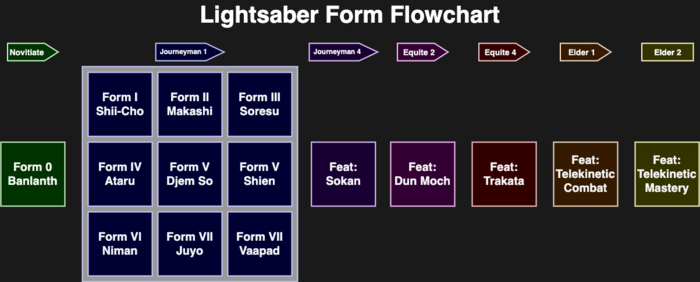 A Flow Chart of Lightsaber Forms
A Flow Chart of Lightsaber Forms
Form 0 - Banlanth
Description
Wielding a lightsaber is difficult, dangerous, and requires a connection to the Force to truly master. Banlanth training allows Journeymen to learn the foundation of lightsaber combat before advancing to one of the true Forms at the rank of Knight. The ability to use a lightsaber at all is an incredible advantage in combat which should not be overlooked, though a member employing Form 0 will quickly become outclassed in a lightsaber duel against a Jedi employing any of the other Lightsaber Forms. It should go without saying that this level does not provide the competency for a user to properly wield multiple lightsabers simultaneously or a saberstaff.
Grip and Stance
Banlanth trainees are taught to use both hands, as lightsabers are not easy weapons to wield, and at this level, the practitioner lacks the proper touch to effectively control the blade through anything but the most basic techniques. A Jedi learning Banlanth will stand firm and would do best to avoid overconfidence.
Movement
Trainees' strikes should always be deliberate to ensure that every move counts. The Jedi’s training at this level prevents them from effectively stringing attacks together, meaning that most strikes will leave an opening in their guard. As a result, a Jedi learning Banlanth will typically move very slowly and carefully while their lightsaber is activated.
Banlanth teaches the Jedi the foundational techniques that will later evolve into their chosen Form. The Jedi learns how to deflect blaster bolts, block an opposing lightsaber, albeit most effectively in a controlled situation.
Buzzwords
Deliberate, careful, unpolished, untrained, slow, basic.
Weapon Support
- Dual Sabers (No)
- Reverse Grip (No)
- Saberstaff (No)
Notable Adherents
Form I - Shii-Cho
| Shii-Cho |
 |
Buzzwords:
- Aggressive
- Blunt
- Hammering
- Direct
- Forceful
- Bullish
- Offensive
- Overbearing
- Raw
- Straightforward
- Unsubtle
- Fundamental
|
Notable Adherents:
|
|
Description:
Shii-Cho is often known by its moniker of "The Simplest Form" . Some in the Brotherhood use the term derisively, seeing the First Form as something learned only by those who lack the skill to learn anything better. True masters, however, embrace the term, seeing the appellation for the high praise it truly is. Shii-Cho is indeed the simplest of the Forms, surviving the ages on the merits of its intuitive ease and obvious utility. While not ideal for every situation, practitioners of Shii-Cho rarely find themselves at a significant disadvantage. Easy to learn though the style may be, masters are to be underestimated only at great peril to one's dignity and possibly, life.
|
|
Grip and Stance:
Shii-Cho utilizes what is called a "hammer grip” where the hands are kept in direct line with the wrists and forearms. Adherents of Form I typically utilize a two-handed grip to maximize their strength. Some especially strong and confident users may opt to use the Form one-handed, either to more easily combine other styles of combat.
The Shii-Cho user will usually bend their knees, legs slightly wider than the shoulders, both to help with balance and to Form a compact target. The saber will be held in a slightly upwards angle, with the grip roughly at waist level. Adherents usually do not so much walk as shuffle across the floor, with the torso and saber moving to keep facing the opponent.
|
|
Movement:
Shii-Cho strikes are direct, straight-line maneuvers that eschew subtlety for the quickest and shortest path of attack. The adherent will commonly strike from the shoulder to put the most weight behind the attack so as to attempt to overpower those foes whose defenses cannot simply be bypassed. The First Form’s attacks show little in the way of variety or obliqueness, and are mostly direct and focused slashes and chops. Its repertoire, though limited, has been known to fool an opponent expecting a more complex attack.
Shii-Cho has no dedicated defensive moves. Instead, its "blocks" are the exact same maneuvers that the style also uses for offense, literally striking an opposing saber blade. This occasionally falters against opponents wielding more than one lightsaber but is otherwise quite efficacious.
|
Form II - Makashi
| Makashi |
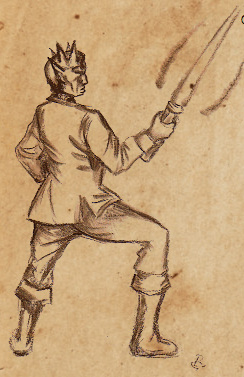 |
Buzzwords:
- Elegant
- Precise
- Fluid
- Swift
- Focused
- Refined
- Smooth
- Counter
- Ripost
|
Notable Adherents:
- Count Dooku
- Assajj Ventress
|
|
Description:
Makashi is often known by its moniker of "The Contention Form" . Developed for the purpose of lightsaber-to-lightsaber combat, Makashi is the most dueling-centric of the Lightsaber Forms, and as a result, becomes drastically less effective against multiple opponents or adversaries with ranged weapons. Relying on precision and efficiency over more basic Forms' wild, sweeping motions, Makashi allows a Jedi to defend himself against a lightsaber wielding opponent with minimal effort, while placing a heavy focus on precise, short strikes.
A Makashi adherent relies much less on their physical strength as their swiftness and the inherent deadliness of the lightsaber. Practitioners of Makashi often prefer to wield a lightsaber with a curved hilt, allowing for a greater effective range of motion with only the flick of a wrist.
|
|
Grip and Stance:
The saber is traditionally held in one of two positions. The first is where the saber blade is held parallel to the floor at chest level, pointing at the opponent with the arm slightly extended so that the elbow is held in front of the body yet still relaxed. The second position is to hold the saber hilt at navel level, perpendicular to the ground but diagonal across the body, with the elbow tucked against the waist. The first position emphasizes offense while the second emphasizes defense.
Makashi's basic stance is to turn sideways toward an opponent as to minimize an adherent’s silhouette and openings. The adherent’s feet should be slightly more than shoulder width apart with the lead foot pointing at the opponent and the trailing foot turned perpendicular in relation to the lead foot for balance. The knees should be kept slightly bent, their weight resting on both feet equally, though some adherents prefer to place most of their weight on their trailing foot. The trailing arm should be held behind the adherent in a protected but comfortable position that would act as a counterbalance to their movements.
|
|
Movement:
Makashi incorporates short, precise thrusts and slashes accompanied by sudden movement changes that maximize energy retention. Defense is as much a part of offense, in the sense that counter-attacks are used heavily within this Form.
Makashi relies heavily on “not being there” when an opponent attacks. The Form provides adequate defense to all but highly kinetic strikes and will redirect most strikes as opposed to offering outright parries, instead incorporating ripostes, which is more of an immediately following attack that is part of a parry. The Makashi user tries to avoid using blocks and blade locks if at all possible, because they occupy the blade without gaining any tactical advantage.
|
Form III - Soresu
| Soresu |
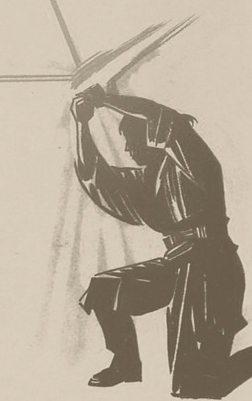 |
Buzzwords:
- Tight Coils
- Clockwork
- Whirlwind
- Basket-Weave
- Impenetrable
- Rebounding
- Bulwark
- Instinctive
- Protective
- Detective
- Untouchable
- Reflective
- Patient
- Invincible
- Efficient
|
Notable Adherents:
- Obi-Wan Kenobi
- Luminara Unduli
- Ki-Adi-Mundi
|
|
Description:
Soresu, also known as the Way of the Mynock or the "Resilience Form" is the most defensive of all Lightsaber Forms. It was born of necessity as blasters became more and more prevalent in Galactic society. Soresu focused on defending the user from multiple attacks, both bladed and ranged. This form offers few attacking strikes and primarily uses parries, deflections and ripostes to protect the adherent from harm. Against a lightsaber-wielding adversary, the Soresu adherent will usually attempt to wait until their foe has tired themselves out, gets sloppy, or presents them with a glaring opening.
With concentration, Soresu users can redirect and aim blaster bolts into a target.
|
|
Grip and Stance:
A single-handed grip places the hand high on the hilt, almost on top of the emitter. The thumb and index fingers are on opposite sides of the hilt and are securely but not tightly held against the hilt. The middle and ring fingers are wrapped tightly around the hilt providing both grip and fulcrum. The little finger is barely touching the hilt. With this grip the thumb and index finger direct the blade while suddenly tightening the little finger will provide the quick snap of the blade needed for one handed deflection of blaster bolts.
The two-handed grip has all the fingers of the dominant hand wrapped around the hilt slightly below the emitter with the thumb coming around and resting on top of the index and middle fingers. The trailing hand is placed just above the pommel with the fingers wrapped in the same manner, but obviously the opposite direction. With this grip, the lead hand guides the lightsaber while the trailing hand moves it.
|
|
Movement:
Defense is king. The dominant side is turned to the rear as the adherent is squared sideways to the opponent. The saber is typically held over the head with a single hand, parallel to the ground pointing forward at the opponent while the off-hand is stretched forward. This allows the user to execute quick spins and displacements as well as the ability to retreat without actually giving up ground. The lightsaber stays in perfect position for drop parries and upward deflections as well as having leverage for sudden offensive sweeps. Adherents will shuffle their feet to move, and find little reason for their feet to leave the ground.
|
Form IV - Ataru
| Ataru |
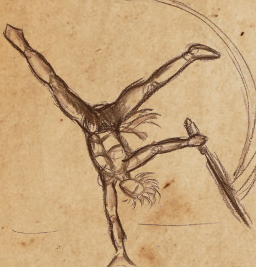 |
Buzzwords:
- Whirling
- Jumping
- Twisting
- Cyclonic
- Dervish
- Acrobatic
- Kinetic
- Sporadic
|
Notable Adherents:
|
|
Description:
The Fourth Form, also known as Ataru, the Way of the Hawk-Bat or the "Aggression Form" was developed and put into practice by the Jedi Order sometime prior to the Mandalorian Wars where it quickly rose in its fame and use. A dynamic, acrobatic Form that focuses on blitzing single opponents with a flurry of furiously aggressive strikes, Ataru lacks in defense and is ill-advised for use against more than one opponent. The acrobatic nature of Ataru is extremely taxing on the body, and as a result, is not ideal for prolonged engagement.
|
|
Grip and Stance:
Held in an almost relaxed grip, the Ataru stylist changes his handling based upon the maneuver. In general, the flexibility in the grip is achieved by using half of the fingers held loosely and the other half held tightly, allowing for easy spins and slices and turns of the wrist.
The typical ready stance of Ataru is quite literally standing motionless. Some masters prefer to turn slightly sideways and bring their saber up in a gesture to show that they are ready as a mark of respect for their opponent. However, when they aren’t idle, the user is in constant motion, either advancing, attacking, or retreating back to a safe distance. More experienced practitioners of Ataru will engage in kaleidoscopic acrobatics to attack from unconventional and unexpected avenues of attack, often utilizing the terrain to rebound off in order to achieve this.
|
|
Movement:
Ataru is a very dynamic and somewhat aggressive Form, calling for a near constant attack stream, relying upon the saberist’s speed and persistence to overwhelm their enemy's defenses. Many acrobatic stunts are used to help catch the enemy off guard and to find gaps in their defenses that the Form IV adherent can access.
Unfortunately the constantly whirling attacks prove to leave the adherent somewhat undefended at many times and occasionally overextended. The major reason Jedi Master Yoda was able to use this Form so effectively was because his small frame made him naturally more difficult to strike. A larger adherent would likely find the weak defenses of Form IV a liability.
|
Form V - Djem So
| Djem So |
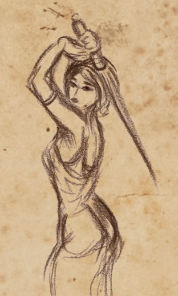 |
Buzzwords:
- Aggressive
- Dominant
- Powerful
- Chained
- Rapid-Fire
- Reflective
|
Notable Adherents:
- Anakin Skywalker
- Luke Skywalker
|
|
Description:
Djem So is the Way of the Krayt Dragon, or more colloquially, the "Domination Form" . Designed as an amalgamation of Makashi’s saber-dedicated precision and Soresu’s muscle-memory effectiveness, Djem So is aggressive and uninhibited. Djem So admires power in all things, seeking to batter down obstacles be they physical, mental, social or spiritual. As a result, the Form's simple aggression belies a dangerous appreciation for strength, and when a foe chooses to directly block a Djem So master’s strike, it may well be the last thing they do.
|
|
Grip and Stance:
Orthodox Djem So practitioners place their dominant hand high on the saber hilt, grasping it tightly so as to maintain a steady grip on the weapon while performing overpowering swings. In two-handed use, the off-hand is then placed lower on the hilt, allowing the user to lever the weapon in mid-swing for additional force.
Djem So adherents typically use a solid stance, with both knees slightly bent so as to maximize their grounding during attacks. Legs and body are typically turned sideways, so as to present the smallest possible target profile. The dominant leg is usually placed to the back, allowing the user to make one forceful strike and then advance, following through with an even more powerful attack. Movements are deliberate and fairly slow, sacrificing mobility for grounding. Almost all trained movements advance the practitioner forward; the style’s inventors deliberately omitted most forms of retreat, feeling that they would detract from Djem So’s offensive focus.
|
|
Movement:
The Perseverance Form is an offensive style employing a wide variety of different attacks, most of them wide-angle swings that bring to bear as much force as the user can muster. The Form also has several stabbing and chopping attacks, mostly used to vary attacks and keep an opponent guessing. Whenever possible, the adherent will use a barrage of different swings following closely on each other, disturbing an opponent’s balance and footing until it is possible to strike a finishing blow.
The Way of the Krayt Dragon has little in the way of defenses, preferring to trust in offensive action to cow enemies. What few dedicated defensive moves the Perseverance Form teaches are almost all ‘reversals’: maneuvers that have the specific purpose of turning the tables on an opponent and regaining the offensive.
|
Form V - Shien
| Shien |
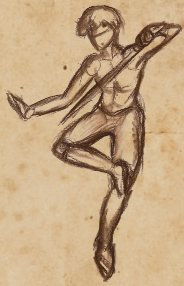 |
Buzzwords:
- Agile
- Channel
- Counter
- Fluid
- Intimidate
- Overwhelm
- Redirect
- Spin
- Swirling
|
Notable Adherents:
|
|
Description:
The “Perseverance Form” or Shien, is the variant on Form V which was developed by Form III adherents who desired more offensive capability. Shien has existed since at least the Jedi Civil War in 3959 BBY. Optimized for blocking blaster bolts rather than lightsaber combat, Shien was less effective against a single adversary, while being very effective when outnumbered.
With concentration, Shien users can redirect and aim blaster bolts into a target.
|
|
Grip and Stance:
Shien fighters often hold their weapons in a reversed grip, but not always. Most tend to favor a single-bladed saber, but dual saber users have found ways to incorporate it into their patterns as well. The grip tends to be low on the hilt for maximum blade length in extended strikes that make it possible to follow through and strikes at range after deflecting an incoming blow, and tightly held for cutting power and quick blade reversals. The reverse grip variety of Shien allowed the user to perform long, sweeping strikes, with the motion of a punch.
Shien favors a wide-based moving stance that is often in contact with the ground surface as the user moves, allowing for maximum leverage.
|
|
Movement:
Shien is a very athletic Form containing many physically powerful strikes. It is, however, less effective in one-on-one duels, where there are fewer opportunities to employ the Form's true strengths, as opposed to an open battlefield on which there will be many adversaries from whom blaster fire or kinetic energy can be drawn and redirected like organized chaos.
Shien defense is generally a good offense, although the style excels at dealing with multiple opponents and blaster-fire. Unpredictable movements also make it difficult to target the Shien artist properly, especially when an adherent will always be responding to an opponent's own movements.
|
Form VI - Niman
| Niman |
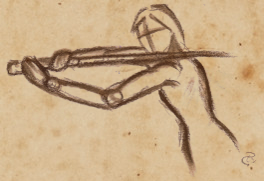 |
Buzzwords:
- Relaxed
- Haphazard
- Flitting
- Casual
- Deceptive
- Reserved
|
Notable Adherents:
- General Grievous
- Exar Kun (Legends)
|
|
Description:
Niman is the Peacekeeper’s Form, also known as the "Moderation Form". Simple, yet balanced and evocative, the Form’s moves and tactics are predicated on equal parts intimidation and trickery. Formed to fight criminals and preserve the peace in the Republic’s peaceful latter days, Niman has surprising utility in the seedy back alleys of the modern Galaxy. The Brotherhood may know legions of masters capable of striking down their foes in a single blow, but only the Moderation Form claims to be able to so with none.
Niman recognizes what many other styles neglect; combat is rarely an end of itself, but a tool to remove an obstacle or a threat. The Moderation Form, rooted as it is in Jedi philosophy, therefore often seeks the least-damaging ways to dispatch their opponent, but often in ways they least expect.
|
|
Grip and Stance:
The Niman user holds his saber with one hand in the center of its grip, maximizing the weapon’s flexibility. The blade is often not extended until the actual commencement of hostilities and, in rest, is kept facing diagonally downward in a deliberately non-threatening - and unthreatened - pose. This changes only when attack is imminent, in which case the weapon sweeps up, kept in an angle directly in front of the user. Maneuvers may be executed one-handedly, but most adherents bring both hands to their saber in serious fights.
Niman users adopt a casual stance in combat, seeming utterly relaxed. They often twist their bodies slightly to the side, so that the saber is held away from the opponent. This, the adherents believe, aids the suggestion of invulnerability when the weapon is brought to bear the moment attack commences. Movements are off-the-cuff and almost lackadaisical in execution, with the user often simply running with the saber slightly to a side. More advanced acrobatics, if they are used at all, tend to utilize the Force.
|
|
Movement:
Attacks are carried out in response to a parried enemy attack, exploiting minute flaws in an opponent’s movements.The result is a style whose attacks seem impulsive and direct but that is, in fact, calculated and reserved. Most attacks take the form of shallow slices from moderate distance. This wide-angle ensures deliberately superficial cuts that can often wound rather than kill. Furthermore, it ensures the wielder a broad perspective of the battle, and gives them the opportunity to attack - or defend against - multiple adversaries.
The Peacekeeper’s Form is often primarily a defensive art. As with their attacks, most defensive moves by the Niman user are done at some distance to the opponent, and are preferably quick deflections rather than forceful parries in order to prevent the wielder from being bogged down too long by any single opponent. Such deflections are often haphazard and seemingly random swings that take their guidance from the Force rather than rote knowledge.
|
Form VII - Juyo
| Juyo |
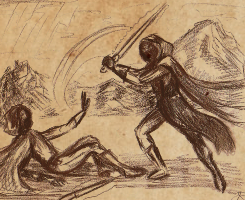 |
Buzzwords:
- Chaotic
- Dangerous
- Determined
- Exhausting
- Fast
- Ferocious
- Forbidden
- Overwhelming
- Passionate
- Quick
- Swift
- Tiring
- Unrelenting
- Unpredictable
|
Notable Adherents:
|
|
Description:
Juyo is not a Form that the Jedi Order think warmly of, and for good reason, as some claim that Juyo originated as a Sith fighting style. Better known by its alternative title, the "Ferocity Form" , the Seventh Form is vicious and unpredictable, calling heavily on the wielders' emotions and passion to overpower opponents. It has been alleged that Juyo was the reason so many Jedi Knights fell to the Dark Side during the Dark Age and the last Sith War. For this reason, Juyo has always been looked down on by the modern Jedi Order - but for this same reason, the Seventh Form has been welcomed like a lost son by the today's warriors of the Dark Side.
|
|
Grip and Stance:
Juyo practitioners tend to grip their lightsabers firmly, usually seeking the balance point on the blade's hilt. This allows them to keep hold of their weapon even when their mind is submersed deep in the battle and their attacks driven by their desire to succeed more than their own safety. Reverse grips are known, as are two-handed blows when appropriate, especially when using twin-bladed lightsabers.
Proponents begin with their body half-twisted to the side and their lightsaber held horizontally above their head in a high guard that they can quickly transform into a downward slash. Like a wild animal waiting to pounce, those trained in the Seventh Form will also keep their knees half-bent so that they can spring nearer their opponent at any moment in order to strike.
|
|
Movement:
When an adherent of Juyo starts their attack, they simply surrender their mind to the battle. This raw excitement for combat makes their offense fast and relentless, with Juyo seeking to overwhelm opponents — even Soresu masters — under the sheer volume of attacks.
The best defense is a good offense, and adherents of the Ferocity Form spend far less time learning how to block compared to any of the other traditional Jedi Arts. The only defense that instructors spend much time teaching is the defense before the battle is joined, with proponents learning how to shield themselves in anticipation of the right opening — from which they can then sink themselves into the Juyo battle mindset and trust that their superior offense will quickly bring down their opponent before they exhaust themselves of their own energy reserves.
|
Form VII - Vaapad
| Vaapad |
 |
Buzzwords:
- Blurred
- Constant
- Control
- Deceptive
- Explosive
- Ferocious
- Flowing
- Liquid
- Precise
- Rapid
- Swift
- Unpredictable
|
Notable Adherents:
|
|
Description:
The sibling of Juyo, Vaapad, or the "Paradoxical Form" is a variant of the Seventh Form, with the primary difference spawning from the adherent's state of mind. Vaapad requires practitioners to feed constantly on the Force and to perfect the art of mentally connecting with their opponent to become one half of a superconducting loop. Unlike Juyo, however, Vaapad is much more about control than surrender, and requires practitioners to relish winning a fight, without succumbing to their baser instincts completely.
|
|
Grip and Stance:
Like Juyo, adherents of Vaapad cannot always predict where their body will take them when they partially surrender control of their actions to the Force, and for this reason most choose to maintain a strong grip on their lightsaber to prevent their weapon being knocked out of their hands when they are submerged in the Force.
Vaapad retains the basic ready stance of its ancestor, with the body only half-facing one's opponent, and the lightsaber held above the head in a high guard that can either be lowered into a full block or redirected into an attack should the moment arise. Like Juyo, Vaapad focuses on speed rather than strength and proponents will frequently keep their knees bent so that they can launch themselves — either toward their opponent or away to safety — more quickly.
<br
|
|
Movement:
Those trained in Vaapad are driven by their desire to succeed and defeat an opponent, and like Juyo, adherents of Vaapad will aim to wear down an opponent underneath a tide of rapid attacks. Unlike Juyo, however, a Vaapad adherent does not exhaust themselves by trying to replicate the heavy strikes or rapid footwork of other Forms. Instead, they seek the path of least resistance and will aim to deflect incoming attacks. Control is key with Vaapad, and newer adherents are susceptible to quickly tire if they do not maintain their focus. Provided they do not succumb too deeply to their battle lust, a Vaapad adherent will take the time to step back, defend, and give themselves a moment to reflect on the situation rather than bombarding an opponent with the hope that they wear out first.
|
Jar’Kai
| Jar’Kai |
| File:Jarkaiformimage.png |
Buzzwords:
- Adaptable
- Balanced
- Commanding
- Cyclonic
- Dominating
- Fast
- Overwhelming
- Powerful
- Resilient
- Resourceful
- Responsive
- Swift
- Twin-Handed
|
Notable Adherents:
- Assajj Ventress
- Ahsoka Tano
|
|
Description:
One of the oldest Forms of swordplay, Jar'Kai is the art of wielding more than one blade at the same time. While the use of two weapons predates both the lightsaber and the Jedi Order, and the word Jar'Kai itself has entered the common lexicon and is often erroneously used to refer to any use of two blades together, the contemporary style known today as Jar'Kai refers to a specifically refined use of two lightsabers that has links to the Sixth Form, Niman.
|
|
Grip and Stance:
Proponents of Jar'Kai always seek to maintain as tight a grip in each hand as possible in order to avoid being disarmed. The chief exception to this is sometimes seen in those who come to Jar'Kai with a Makashi background, and whose familiarity with ways to parry an opponent's weapon and avoid direct contact makes it easier for them to keep a looser grip on their second blade — something made even easier if they choose to carry only a shorter shoto.
Jar’kai practitioners often favor the use of a single traditional lightsaber in their dominant hand and a Shoto blade in their off-hand. The secondary lightsaber is often held in a reverse grip and is used mostly defensively.
Since Jar'Kai is never a style that one learns the first time they wield a lightsaber, the exact style of its adherents is almost unavoidably influenced by the Forms and techniques that a warrior has specialized in earlier in their training. Those who started out practicing a defensive style are more likely than not to hold back their trail sword. In contrast, those who have spent their earlier years learning the ways of the offensively styled Forms are more likely to see their second blade purely as a weapon, and employ both weapons for offense, and so their stance will be likely to be head-on, with both weapons aimed toward their opponent in an aggressive posture.
|
|
Movement:
The second blade naturally means that an adherent of Jar'Kai is able to attack more quickly and bring multiple attacks at the same time. This enables those trained in Jar'Kai to easily overwhelm an opponent underneath the sheer volume of attacks, as well as to cope better when faced with multiple foes. This does, however, come with a cost. The inability to hold both hilts in both hands means it is impossible to bring forth the same raw strength as somebody who is trained in a single-bladed Form, which can make it harder for Jar'Kai to break through the defenses of protective styles.
It also means that an adherent's guard will not be as strong as it would be holding a single blade with both hands. To compensate, proponents channel their offense into a form of defense, with the trail blade being used simply to halt or pause an opponent long enough to bring their second blade to bear and force their attacker back on the defensive themselves.
|
Sokan
| Sokan |
| File:Sokanforms.png |
Buzzwords:
- Evasive
- Unorthodox
- Nimble
- Agile
- Athletic
- Chaotic
- Dynamic
- Sweeping
- Wide
- Kinetic
- Mobile
|
Notable Adherents:
|
|
Description:
Often thought as just a technique or a principle of lightsaber combat rather than a true Form unto itself in recent times, Sokan is actually much more than it seems. It is a dynamic Form in its own right that utilizes sweeping movements, aggressive mobility, and the entire battleground itself against their opponent. Adherents work to use the terrain, obstacles and distance to balance evasive defense and kinetic offense.
The focus on training solely in Sokan does not come without its own drawbacks. Members who have focused solely on their training in Sokan struggle when forced into scenarios where they cannot take advantage of space and terrain. Confined facilities and flat terrain like deserts leave little for a Sokan user to use towards their advantage, making them susceptible to more technically grounded lightsaber style adherents.
With concentration, Sokan users can redirect and aim blaster bolts into a target.
|
|
Grip and Stance:
Very similar to the Ataru Form, the grip of Sokan utilizes a very loose grip, half of the fingers grasping the hilt tightly, the other half barely touching. The fingers often alternate tension based on the maneuver, allowing for tight arcs, quick drawing cuts and defensive spins and ripostes.
Turning slightly sideways to present a smaller target profile, the ready stance tends to cause an adherent to lower the head a little, allowing their peripheral vision to keep their options open for evasive maneuvers as well as take stock of their surroundings for any advantage. The Sokan adherent is motionless only when their enemy is, baiting them to attack and give the adherent something to work with. Constant motion is used as a method to frustrate and bait opponents, as well as to gain the upper hand. Perfection of the Form requires endurance and flexibility, as the core principles of this antique Form demand near constant motion.
|
|
Movement:
As defensive as Ataru is aggressive, Sokan uses movement and acrobatics to first place themselves out of harm's way, then use the same motions to lash out and retaliate with attacks of their own. Many of Sokan’s strikes are used to test the enemy's defenses or to set up opportunities to deliver devastating strikes from unorthodox angles of attack.
Sokan has some of the best defense available in its incorporation of excessively quick strikes and flexible velocities that allow for defense from nearly any angle. Sokan’s defensive take on Ataru also makes it one of the only Forms that incorporates the specific study of an opponent's movements and style to adapt and counter against.
|
Advanced “Styles”
Further study of lightsaber combat can be explored at the ranks of Equite 2, and Equite 4 with two unique lightsaber “Feats.” These techniques do not represent a complete combat philosophy themselves, rather they tend to be situational tools that utilize a lightsaber-wielder’s ability to harness the Force in addition to the blade or the unique properties of the lightsaber as a weapon.
Dun Moch - Feat (Equite 2)
The character has learned to incorporate the principles of ‘Dun Moch’ into their Primary Lightsaber Form. By actively seeking to completely dominate his opponent’s will to fight with aggressive displays of power and flare, the character weaves taunts like fuel for the fire, and is not beyond using the Force in fits of showmanship. The character will then gamble on the openings created in hopes of the opponent's guard slipping.
Trakata - Feat (Equite 4)
The character has mastered the ability to incorporate the principles of ‘Trakata’ into his Primary Lightsaber Form. This involves the subtle nuances of activating and deactivating his lightsaber blade in the heart of combat at key tactical moments. Usually dismissed by saberists as a gimmick, a true Trakata user knows how to compensate for the split-seconds of vulnerability that the risky technique carries with skill and precision.
Telekinetic Combat - Feat (Elder 1)
The character can take control over weapons or objects with his Telekinesis and use them effectively in combat as remote weapons. Proficiency is based on the character’s Force Power level in Telekinesis, and requires hand gestures to act as focus guides for the invisible hands that guide the weapons.
Telekinetic Mastery (Elder 3)
A master of the Force, the character can control weaponry with his Telekinesis alone, without the need for hand gestures or concentrated focus. This allows the character to fight while maintaining control over the telekinetic combat.